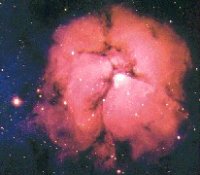|
M20
- The Trifid Nebula
The
@stro object for the week of 03/13/2000

image
courtesy of SEDS
M20 - The
Trifid Nebula. The
Trifid Nebula became "M20" in Charles Messier's catalog,
but it got its "Trifid" name when it was viewed by John
Herschel who noticed the appearance of "tri" or three
different segments separated by dust lanes. It is also part of the
NGC catalog with a designation of NGC 6514. The estimated distances
to the Trifid vary widely between 2000 and 5200 light-years away.
Emission nebula
are nebula that are visible because of radiation from nearby stars
exciting the gas in the nebula. Reflection nebula are nebula that
are visible because they are reflecting the light of nearby stars.
The Trifid Nebula is consists of both emission and reflection nebulae.
The red areas visible in the image are the emission nebula portion
and are powered by a bright triple star system named CC24537. The
blue areas are visible as a result of light reflected from a nearby
O-Type star.
On a night of
excellent seeing and dark skies the Trifid Nebula is reputed to
be visible to the naked eye, but it will surely show up in modest
sized telescope. Right now is the best time of year to undertake
the "Messier Marathon", which is a marathon to locate
and observe all of the objects in Messier's catalog. For more on
the marathon check out the SEDS Messier Marathon webpage.
| Current
information for the M20 (North America): |
| Rise: 1h
48m 57s |
| Set: 6h
31m 57s |
| R.A.: 18:02 |
| Dec.: -23:02
|
| Magnitude:
6.3 |
| Constellation:
Sagittarius |
more
info from SEDS...
more
info from Bill Arnett's site...
|